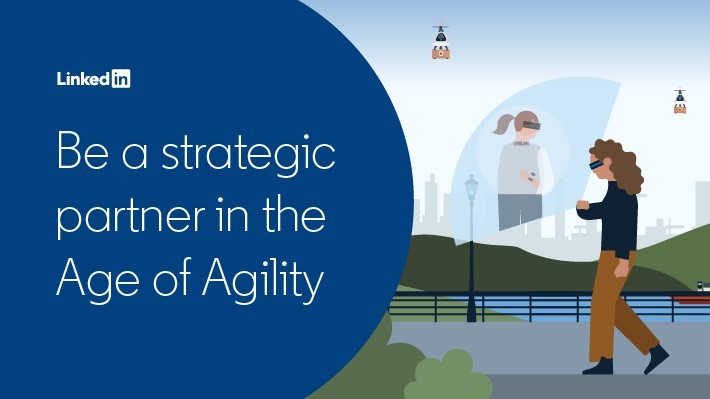Tech vendors must show they’re a strategic partner in the Age of Agility
Technology adoption has been at the heart of businesses’ response to the upheaval of the last 12 months. In fact, McKinsey reported that digitisation has accelerated by as much as three to four years during the pandemic. For technology vendors, this sudden rush to digitise is a chance to showcase their solutions and win new customers, by easing the transition to a more virtual world. But, faced with economic uncertainty and fierce competition from rival solutions, tech marketing is far from straightforward, and demonstrating return on investment is more important than ever.
Now in its seventh year, The LinkedIn B2B Technology Buying Survey provides a snapshot of how 2,000+ tech buyers across Europe, the Middle East and Africa, are responding to the current business landscape. Business resilience is key today, in an era we’re calling the Age of Agility. The report found that buyers are conflicted between the need to invest in technology that will give them the resilience to withstand current challenges, and the need to rein in spending in response to economic uncertainty. Every business has been affected in different ways during the pandemic, with some seeing their operations put on hold, while others have profited from new opportunities, or at least found temporary solutions to maintain revenues until the storm passes.
So, with their buyers in a state of flux, how can marketers navigate this new landscape? Achieving cut-through not only requires solutions that are seen as indispensable, but also vendors who can show that they are experts and strategic partners during tough times.
Becoming a trusted expert to attract anonymous buyers
We know that today’s technology buyers like to remain anonymous in the early stages of the buying process, with the LinkedIn Report finding that 70% do their own research before reaching out to your team. But that doesn’t mean brands can’t engage with these invisible buyers early on, and it’s the marketer’s job to ensure that the whole buying committee has everything it needs, at the right time. That includes a clear picture of what your solution can offer, the strategic value it will deliver, and how quickly they will see results.
With figures showing that four out of five employees are involved at some point in the tech buying process, detailed market research and data mining are vital to build a picture of who these anonymous buyers are, the strategic problems they’re facing, and what they’re looking for, so your messaging can be tailored accordingly. The report found that price is the top consideration for buyers today, so content should be transparent about how pricing works and what is included for the cost. Similarly, they like to see detail on products and features, profile these clearly, alongside business outcomes, whether that’s potential cost savings or increased revenue. Case studies and testimonials can provide the social proof to back these claims up.
In LinkedIn research, only 25% of B2B buyers say that they’re willing to share details to access interesting content. As anonymous buyers are unlikely to approach the sales team if they have a question, ensure that your content answers every possible query that they might have, leaving it ungated to avoid scaring them away. Three quarters of buyers say that knowledge and experience are important to the choice of vendor, so profile your senior people and develop thought leadership content offering insights on the key trends and challenges that organisations like theirs face in the current climate. Show that you are at the forefront of thinking in the industry and can offer strategic value as well as technology; that you can help their business to be more agile and, most importantly, grow.
Finally, provide a clear timeline for implementation and details of the after-sales support that customers can expect; a deciding factor for over half of buyers (56%). Forrester research found that currently no brand is differentiating themselves on customer experience, making this a missed opportunity to drive retention and renewals. So, make sure messaging is clear and transparent about the customer service and time-to-value.
Driving value and retention post-sale
Proving your strategic value pre-sales is only half the story. With budgets under pressure and buyers looking to see fast returns, if marketing touch-points aren’t complementary to the implementation process and post-sales experience, then your customers won’t hesitate to jump ship to one of your competitors. But exceed their expectations, and you significantly increase the chance that they will stick around for the long-term, saving on customer acquisition costs, reducing churn, and providing opportunities for upselling, cross-selling and positive reviews from satisfied customers.
So, what does strategic value look like post-sales? In short, tech buyers want to know that you are as focused on delivering ROI for them, as you were on selling to them in the first place. Ensure that there is consistency in personnel and messaging as you move from sales to implementation, by empowering sales and marketing teams to collaborate on communications with clients during the handover, onboarding and beyond. Implementation processes can be lengthy, taking up to four months, so it’s vital to keep buyers engaged throughout this period, providing regular updates on progress and addressing any stumbling blocks quickly.
Once implemented, post-sales support should be as personalised as possible, for example by mining data to provide advice specifically relating to a customer’s challenges, providing tips on the product features that they find most valuable, or ways that the product can further support business growth. Clients should be supported however they prefer to work, whether that’s through self-directed support on the website, through online events and videos, via online chat, or by speaking to customer service representatives directly. And this personal approach should continue when it comes to renewal, ensuring that the client’s needs continue to be met as the relationship develops.
Becoming indispensable
Today’s tech buyers are spoilt for choice, and ever-increasing innovation combined with budget pressure, mean that their expectations regarding service and KPIs are rising all the time. Amid constant change, agility is key – both in technology and marketing. Old tried and tested methods can no longer be relied upon, so marketers must stay on their toes and find new ways to show and add value, in response to the real-time challenges that customers face. Welcome to the Age of Agility.
The LinkedIn B2B Technology Buying Survey – Age of Agility EMEA Report lays out the five key trends in a new and dynamic landscape for technology marketers. Discover what your buyers need from you today.
Related articles



